| We wanted to see at least one of the famous Fiordland Sounds and chose to spend
a lot of money for an entire day of touring by boat and bus. When Cook
named this fiord Doubtful Sound he was mistaken in two ways. Firstly this is a fiord
because it is carved out by glacier. Sounds are carved out by rivers. Second he was
doubtful that he could sail into the sound. Several years laters Malespina sailed into the
sound and charted it for the Spaniards. |
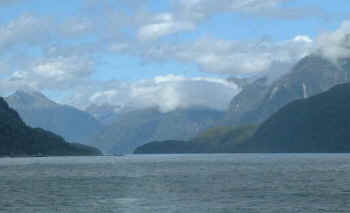 |
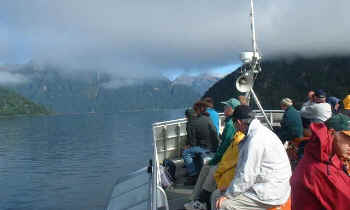 |
The morning boat ride across Lake Manapouri started out a bit foggy. But as we
progressed across the 15 mile long lake the mist rose and the surrounding mountains were
revealed. After the 60 minute crossing we arrived at the Manapouri
Generating Station docks and boarded busses for the roadtrip over Wilmot Pass to Doubtful
Sound. |
| The road to Wilmot Pass was built to service the building of the Manapouri
Power Station. Fortunately the gravel road will remain to take tourists to the head of
Doubtful Sound. Otherwise an uncomforatble, and distant, sea voyage from Invercargil or
Milford Sound would be necessary to see this beautiful sound. Moss
covered mountain beech trees line the road until just below the pass. At the pass the
windy weather and drier conditions stunt the trees and make it imposible for them to
survive. |
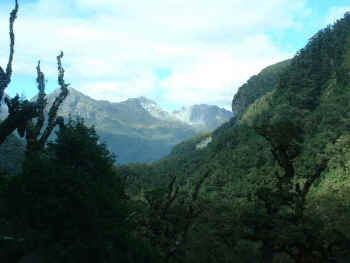 |
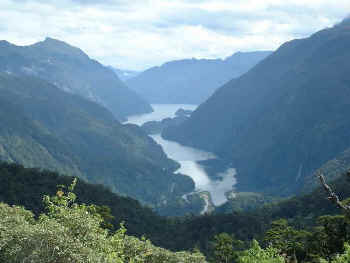 |
From a view point at Wilmot Pass, Doubtful Sound is visible as it winds it way
between the mountains to the Tasman Sea. Wilmot Pass is about 600 metres
above sea level and the gravel road descends in a series of switchback curves down the
westrn slope. The bus driver went very slowly as we made our way down. Fortunately we only
net one tandem dump truck along the way that was safely tucked in a layby. |
| Once safely aboard the second boat of the day we were off to see the sights of
the sound. It had been fairly dry for the previous two weeks and many waterfalls were
thin. However this one peeked out from the thick forests along the shores. |
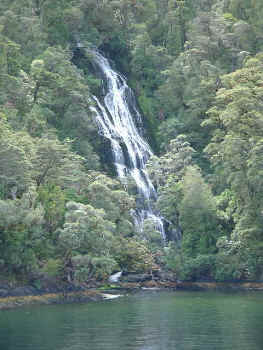 |
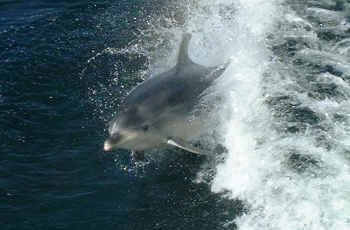 |
A school of dolphins feeding along the way decided to have some fun in the
wake. Two dolphins managed to swim in the wake as we sped off at 20 knots. |
| It took about one and a half hours to reach the Tasman Sea. There is an island
at the mouth of the sound and it is easy to see why Captain Cook thought he may have
prblems sailing in and out of the narrows. There are many rocks around as well. |
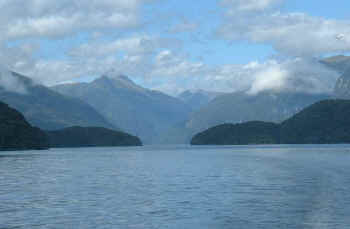 |
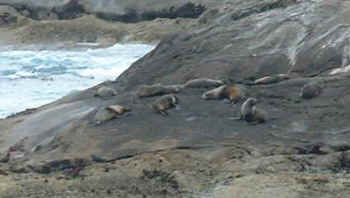 |
A large fur seal colony calls the rocky islands home. Most of the animals we
saw were young seal pups. The parents had already gone to their winter fishing grounds. |
| On the way back to the Manapouri Generating Station docks we were taken into
the tunnel leading to the turbine room 200 metres below the lake. The 2Km spiral tunnel,
only just narrow enough to allow two busses to pass by, was blasted out of solid rock.
There are only a few places were reinforcement is required. This was a tense time for us
as we do not like to be enclosed in either caves or tunnels. However, we did want to see
the generating station. |
 |
 |
At the bottom of the tunnel we walked about 100 meters to a viewing platform
overlooking the turbines. This is a cavernous room, brightly lit, filled with the sound of
water rushing in the distance. |
| Two hundres metres above the water intake directs Lake Manapouri water down
tunnels to each of the 7 turbines. The tailrace for some reason does not allow water to
flow freely and ony 5 of the turbines can operate at a time. This is being corrected with
a new tailrace tunnel running parallel to the old one. The power
generated here is used at the aluminum smelter at Bluff. |
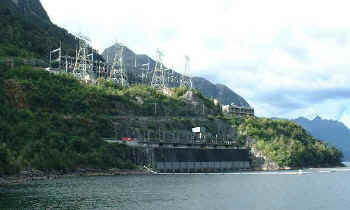 |
|
 S/V
TETHYS
S/V
TETHYS S/V
TETHYS
S/V
TETHYS